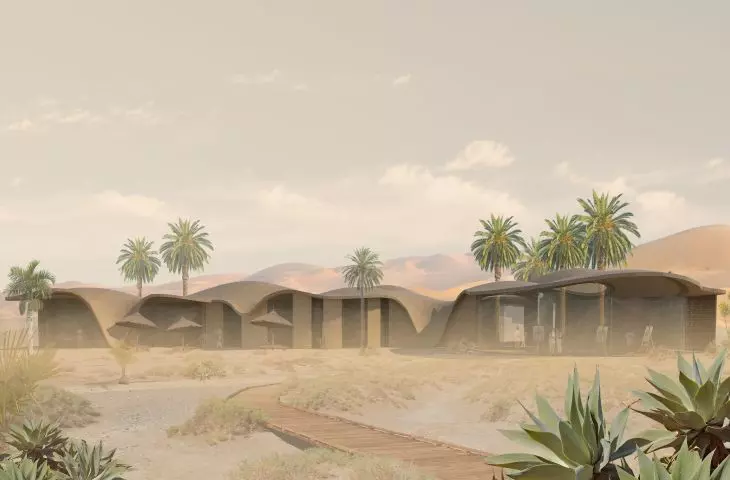Veronika Gielo and Daria Uss, architecture graduates from the Sopot Academy of Applied Sciences, have designed a plus-energy and carbon-neutral Cultural Center in Morocco. Their project "Milieu," part of their master's thesis, participated in the international competition "The Oasis Cultural center" of the UNI platform and received an honorable mention.
The goal of the competition held under the auspices of Chafik Zeroukki, an architect with Zaha Hadid Architects, was to design a cultural center at the Moroccan oasis, next to the Barrage Lalla Takerkoust reservoir. Progressive climate change, economic collapses and inappropriate environmental policies have negatively affected further areas of Marrakech, which have become unattractive and insufficiently financially rewarding. For this designed facility was to revive tourism, which is one of the main sources of income, and this would consequently improve the living conditions of the local community.
The Cultural Center is a place for artistic activities
© Weronika Gielo, Daria Uss
The proposed cultural center was to be an example of a green city - where energy use, alternative energy, recycling and sustainability are implemented as an example for the rest of the region. The main idea was to create a facility compatible with traditional building technology, thereby providing ecological solutions in terms of energy.
honorable mention for polish students
The projects submitted for the competition were evaluated by a jury consisting of: Meritxell Inaraja (Meritxell Inaraja ARQUITECTA, Spain), Tarik Oualalou (OUALALOU+CHOI, France), Isabel Collado (DOSIS, Spain), Ignacio Peydro (DOSIS, Spain), Mohamed Bennani (Mohamed Bennani Architects, Morocco). Among the awards given were: two Grand Prizes, the Audience Award and six honorable mentions, among which was the "Milieu" project by Weronika Gielo and Daria Uss. The proposal was made as a master's thesis under the direction of Dr. Bartek Felski and Dr. Justyna Martyniuk-Pęczek.
projection and design analysis
© Weronika Gielo, Daria Uss
The task of our project was not only to respond to the assumptions required by the organizer of the competition, but also to open up to the needs of the local community, and not only to the needs of tourism. The socio-cultural problem clearly highlights how unemployment, including of educated people, as well as cultural isolation of women plays a big role in the country. To this end, we have created a utility program that also includes women and youth in education and employment, as well as conducting courses in handicrafts and products, using local materials, the authors explain.
universal design
The Cultural Center project is an example of architecture that is not only interesting in terms of its massing, but also in terms of the possibilities it will offer and fulfill for the surrounding population. All the technical solutions used in the project are ecological and environmentally friendly.
The design of the Cultural Center in Morocco, sections
© Weronika Gielo, Daria Uss
This is an example of construction that, due to the simplicity of execution, the materials used, as well as the program, can be erected anywhere in the world, including Morocco, and serve smaller populations for educational purposes, as well as being a model for creating architecture that coexists with the environment, the architects add.
recycled clay and plastic walls
The goal of the project was to create a plus-energy, carbon-neutral cultural center designed according to the principles of sustainable construction, in which ecology and environmental friendliness were a top priority.
The walls were made of clay, and the openwork refers to local culture
© Weronika Gielo, Daria Uss
The authors designed the interior and exterior of the building entirely from clay with an admixture of goat and camel hair, ash and plastic. The inner courtyards, which are a characteristic element of Morocco, make the building blend in with its surroundings.
While working on the project, the students conducted research to create the clay wall with their own hands and observe its character, behavior and possibilities, including the possibility of foundation anywhere in the world.
plus energy cultural center
The authors believe that architectural solutions, as well as appropriate greenery design, based on the use of Oxytree trees, will create a place that is a plus-energy facility after nine years, and carbon-neutral after twelve years. Modern architecture and interesting solutions will make the facility a frequently visited place on the map of Morocco, and it could itself become an example that can be replicated in other areas.
The Cultural Center fits into the landscape of Morocco
© Weronika Gielo, Daria Uss
The use of local materials, the reference to traditional construction techniques, the use of plastic, and the way the mass is formed is proof that we are able to design architecture that identifies with the place where it is located, being an element that emphasizes a given landscape, giving the impression as if it had always been there, Weronika and Daria conclude.













































